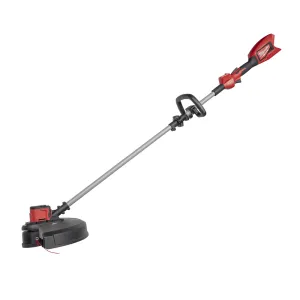Grass is a highly successful and very tenacious plant. Despite appearances, it will continue to grow in very cold weather, albeit at a much slower rate.
However, it is not immune to damage in winter, and paying attention to its needs in the colder months is a great way to ensure you have a lush green lawn ready for spring.
And while there is always less on the lawncare list in winter, there are still jobs that can done to give your lawn a head start come warmer weather!
Keep off the grass
If ever there was a time not to walk on the grass, it’s in winter, but specifically after ice formation, frost or snowfall.
Why? Well, in these weather conditions, ice crystals form between the cells of the grass blade. When undisturbed, these crystals help to protect the important cells from damage. This means the grass is able to carry on with the process of photosynthesis - once the ice, frost or snow has melted.
However, when you walk on frozen or frosty grass, these ice crystals are propelled into the leaf cells, stabbing and damaging the cell walls which leaves the blades brittle and prone to breaking.
Ultimately, the effected grass blades will discolour leaving you with a blotchy lawn.
This means your grass becomes stressed and has to put more energy into repairing itself come spring. Hence it pays to keep off the grass in cold weather.
Keep your grass free of leaves
Although leaving leaves on bare soil, beds and borders is good for your plants, the opposite is true when leaves are left on grass.
Over winter, leaves block the sunlight and deprive the grass of water and nutrients. This can kill the grass and leave bare muddy patches underneath leaves.
The grass will eventually grow into these patches in the following year (given the right nutrition, conditions and care), but often, you may find that weeds or moss beat the grass to it meaning you need to remove these unwelcome visitors and re-seed.
To avoid this problem in spring, grab your leaf blower and get rid of leaves that fall on grass. Given the previous point, only attempt to remove leaves from grass when it isn’t frozen or frosty. Check out our guide to leaf removal here.
You can make leaf mould from these leaves – benefitting your plants next year. Just pile them up inside a chicken wire cage or anywhere that air can get to them, and they won’t blow away.
Aerate your lawn
Aerating your lawn in winter helps improve drainage and supports a healthy root system.
Avoid scarifying as you may inadvertently create bald patches in your lawn that can stress the grass and give you another unnecessary seeding project come spring.
Aerate the grass when it isn’t frozen and use a fork in winter rather than a hollow tine aerator. Push the fork as far down as it will go, then tilt it back slightly before removing it.
Try and maintain consistency in your aeration patterns, keeping them in lines equal to the width of the fork tines until you’ve covered your lawn.
Aerating your lawn in winter will also help reduce the amount of moss that can grow, given that moss likes damp conditions and a lack of drainage.
Edge and shape your lawn
Winter is a great time to reshape your lawn, cut clean edges around beds and borders and smarten up edging ready for spring.
Edging in winter lets you remove sections of grass that might have overgrown or died back. With fewer plants in full growth, it will give you the opportunity to assess your garden layout and available space for new planting in spring too.
Use string or hose to mark out curved edges, or stringline and pieces of wood to mark out straight lines. A spade or half-moon cutter is all you need to cut the edges and create formal neat lines.
If using a spade, push it into the earth to a depth of about 3 inches, overlapping each cut slightly as you go along. Lift and compost the turf that you remove.
Where you just want to neaten rather than reshape, use a pair of edging shears or a line trimmer – if the grass is not frozen or frosty.
As long as it is mild and dry, you could finish off with a mow, but do check out our guide to mowing wet grass before you start.
Need more inspiration for winter gardening? Check out some of our winter guides and blogs:
• Article - Reasons to Get Gardening in December
• How To Guide - Guide to Winter Hedge and Shrub Maintenance
• Problem Guide - How to keep rats and mice at bay in winter
• How To Guide - How to Reuse a Christmas Tree
• Article - How to Use Horticultural Fleece
• Article - When to Plant Spring Bulbs
• Article - Guide to Garden Waste
• Article - How to Store Garden Tools
• How To Guide - Autumn/Winter Paddock Care Guide
• How To Guide - How to De-ice a Driveway
• How To Guide - How to Eliminate Algae Using Sapphire Pro












